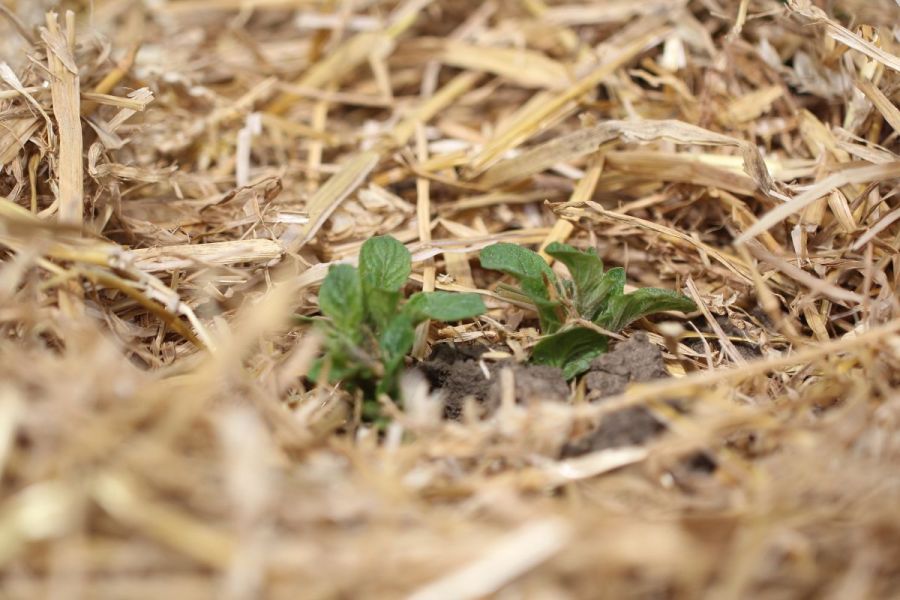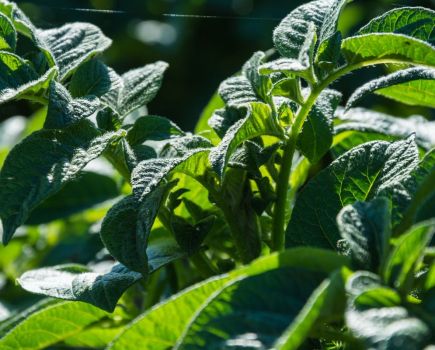Evidence continues to build for the effectiveness of straw mulching to help control potato viruses and with new mineral oil products like Olie-H on the horizon, the UK should soon be equipped with an integrated pest management (IPM) strategy for seed crops. CPM reports.
“PLRV seems to be increasing apace and it’s a worry, because it’s not only being found in a couple of susceptible varieties.”
By Lucy de la Pasture
No one solution will stop potato viruses getting into seed crops, but integrating a range of measures is proving to help suppress mosaic and leaf roll-causing viruses here and in Europe.
In Scotland’s seed certification scheme, seed potato crops are inspected twice during the growing season by SASA inspectors looking for off types and signs of disease. In 2022, these inspections showed a healthier picture for Scottish seed crops, with 75.4% having no signs of virus infection whatsoever. About 17% of the seed crop area was classed as ‘low incidence’, which means between one and five symptomatic plants were found in 10,000 inspected.
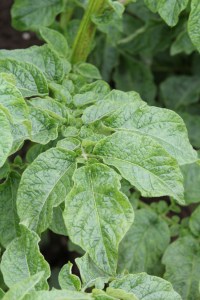
No one solution will stop potato viruses getting into seed crops, but integrating a range of measures is proving to help suppress mosaic and leaf roll-causing virus.
Symptoms observed essentially represent secondary virus infection that originated from primary aphid-borne infection in the previous growing season. Further good news is that the incidence of mosaic-causing virus infections – largely caused by the dominant PVYN variant – reversed the upward trend across Great Britain since 2018.
While the overall picture looks encouraging, SASA advises caution as drilling into the detail puts the spotlight on a problem that has to be addressed by the seed industry right away – a message echoed by Scottish Agronomy’s Eric Anderson, who is a member of the Scottish Aphid Borne Virus Working Group (SABWG), alongside experts from SASA, SRUC and James Hutton Institute, amongst others.
“Potato leaf roll virus (PLRV) seems to be increasing apace and it’s a worry, because it’s not only being found in a couple of susceptible varieties, but across the top 30 grown in GB,” says Eric.
PLRV incidence was recorded at 9.4% of the 2022 seed area, continuing its upward trend from 3.5% in 2020 and 5.0% in 2021. This is contrary to PVY incidence, which decreased from 14% to 10% over the same period, although it remains the biggest cause of virus symptoms found in seed crop inspections.
Aphid vector pressure was significantly above average in some Scottish seed-growing regions during 2022, so Eric expects PLRV levels will continue to rise in 2023. “Once you understand the vector pressure seed crops were exposed to in 2022, and consider we now have fewer effective systemic insecticides for control of persistent virus, this has to be taken seriously,” he warns.
There are plenty of unanswered questions surrounding the increase in PLRV incidence and it might take time to find answers. Until recently its incidence had dropped in the EU, so research largely dried up. Eric believes this vital work should be restarted to find out whether the virus might have mutated and is behaving differently in the field, or if the importance of some aphid vectors is underestimated.
SASA uses virus inoculum pressure from the past season and incidence from specific species of aphid, known to transmit the viruses efficiently, to forecast the percentage of seed crops likely to be infected by mosaic virus and PLRV at the coming inspection.
For PLRV, aphid species currently providing the best statistical support to the SASA model are the peach-potato aphid, willow-carrot aphid, shallot aphid and black bean aphid. An absentee from this list is the potato aphid and AHDB-funded work by Fera virologist, Adrian Fox, suggests it has a PLRV vector efficiency of between 0.15 and 0.89.
The figure of 0.15 is the one most frequently quoted, but if the species is at the 0.89 end of the spectrum it’s almost as efficient as the peach-potato aphid, he points out. In addition, the numbers of potato aphid trapped in recent seasons have risen making it potentially more significant in the spread of PLRV than many perceive.
“I think this is an important point and could be one of the reasons why the recently observed levels of PLRV have been above the levels predicted,” notes Eric.
SASA’s senior virologist Christophe Lacomme says there could be a correlation between the changes in area of carrot crops grown near potato seed fields and the increase in PLRV. Volunteers allowed to thrive in carrots may be acting as a source of PVY and PLRV inoculum, highlighting the importance of controlling groundkeepers throughout rotations.
He also stresses the importance of post-burndown, pre-harvest sampling of seed, where tubers are taken at random from about 200 plants across the seed lot area. This gives the best representation of virus levels in a stock and is much more useful than post-harvest sampling out of boxes, enabling growers to take problem seed out of the multiplication system.
SASA has seen a marked increase in early tuber testing over recent years, off the back of advice to ramp up efforts to clean up input stocks. Christophe also advocates the measures prescribed in ‘The Six Steps to Effective Virus Management in Certified or Home Saved Seed’, issued by the SABWG.
It gives up-to-date advice on maintaining the high health status of Scottish seed, and Christophe says its layer cake of IPM measures can give an overall suppression of virus on a field and landscape level.
His team is ramping up networking activity with fellow researchers in Europe to help refine this approach, including the use of mineral oils to control non-persistent viruses like PVY, which is much more common in The Netherlands.
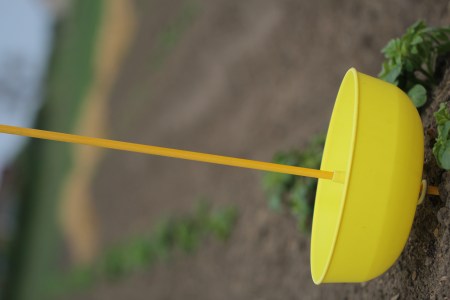
Yellow water traps are used to monitor aphids in potato seed crops.
“We need a combination of measures, including oils. In Europe, they can use greater quantities throughout the growing season and that improves non-persistent virus control. For persistent viruses like PLRV, systemic insecticides are still advised to reduce transmission,” explains Christophe.
Certis Belchim’s Fokke Smit, who has been developing its mineral oil product Olie-H, says it’s a key part of the virus management toolkit in The Netherlands. Unlike in the UK, where just one mineral oil product – Crop Spray 11E – is used in seed potatoes and is only approved up to tuber initiation, Olie-H can be used throughout the season in mainland Europe.
Certis Belchim is now pursuing registration with HSE-CRD, with the aim of offering the product to British seed potato growers with the same or similar conditions of use.
Fokke says maintaining a layer of Olie-H on leaves is critical, as it works by cleaning the stylets of non-colonising aphids before they move on to infect another potato plant. Work carried out in The Netherlands shows that starting Olie-H applications at 30% emergence and spraying at three-to-seven-day intervals through the growing season results in lower virus infection in daughter tubers at post-harvest testing.
“Growers may feel reluctant to start that early but translocation of virus to the developing daughter tubers is much more efficient in young plants, making protection critical at an early stage.
“Aphids are very active at that time too, so if there’s a virus infected plant it can spread very fast,” explains Fokke.
Other IPM measures being deployed in The Netherlands alongside Olie-H include straw mulches, which hinder aphids’ ability to differentiate between soil and plants. Using gauze cloth as a physical barrier is also growing in popularity, preventing aphids landing, while nitrogen input is also being adjusted to influence aphid behaviour.
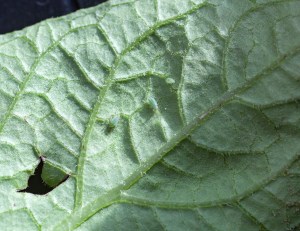
The potato aphid could be underestimated as a vector of PLRV if the vector efficiency is at the upper end of its 0.15-0.89 value, which would put it on a par with the peach-potato aphid.
“Research suggests that higher nitrogen concentrations in the host plant are more attractive to peach-potato aphid, so avoiding over-application of fertiliser could be a way of making crops less attractive,” he explains.
Scottish Agronomy has been testing similar IPM methods over the past two seasons in collaboration with seed producers (see box 1), with programmes including straw mulches, mineral oil sprays up to tuber initiation, and systemic insecticides. He says they remain a crucial part of programmes, particularly against PLRV transmission by colonising aphids.
The 2023 Rothamsted Insect Survey (RIS) forecast is that peach-potato aphids will be flying around two weeks earlier in Scotland this year, which is likely to coincide with emergence of a significant proportion of the seed crop. Systemics will need to be deployed from the start, he advises.
“The new InSyst (acetamiprid) label states that it can’t be applied until after tuber initiation, so growers will have to start with Teppeki (flonicamid) and alternate with InSyst on 14-day intervals while there’s non-colonising aphid pressure in crops,” says Eric.
This year, with planting of seed crops delayed by wet weather, he urges growers to note that the InSyst latest time of application is 31 July. “If programmes aren’t started early enough, it may not be possible to the get final application of four on, so every effort should be made to get seed crops planted and out the ground by the first week to 10 days of June.
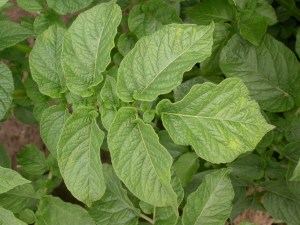
Symptoms of PVYN showing up in Harmony, which remains the biggest cause of virus found in seed inspections even though its incidence fell last year in Scottish seed crops.
“If you’ve used two applications of each systemic product, or have used Tepekki in mixture with oil, no treated crop should be sold as ware as it is against the conditions of use on both labels.”
The importance of aphid monitoring services, like the subscription-based yellow water trap network run by Fera and the suction trap networks operated by Rothamsted Research and SASA, can’t be understated, adds Eric.
Uncertainty surrounds funding of the YWT programme since the abolition of AHDB Potatoes, and the worry is that growers aren’t getting the right intelligence to target insecticides when they will be most effective, he says.
“Monitoring helps keep an eye on the resistance status of key aphid species as well, so the industry can adapt to any changes in populations. We know there are resistance issues to systemic insecticides in Europe and we need to know what’s happening here to make the appropriate management decisions. The potato industry must step up with funding,” he concludes.
This article was taken from the latest issue of CPM. Read the article in full here.
For more articles like this, subscribe here.
Sign up for Crop Production Magazine’s FREE e-newsletter here.

